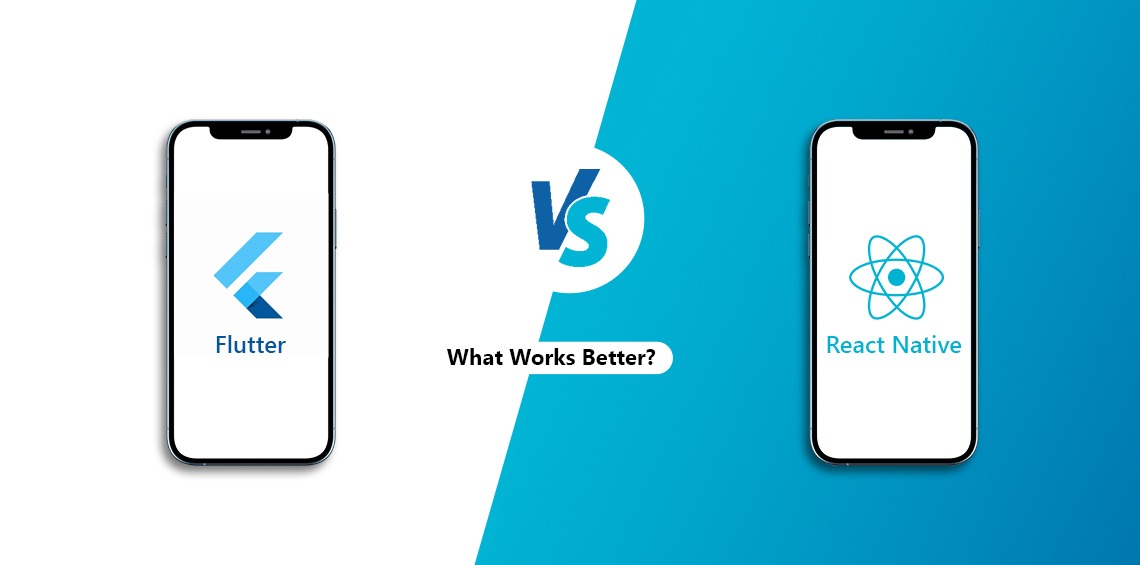There is a growing demand for mobile apps, and many businesses are launching revolutionary products in Apple and Google Play store taking the market by storm. According to Statista, mobile app revenues in 2023 will increase by more than $365 billion. Therefore, there is a lot of opportunity ahead and get an idea of what technologies work better for your business.
Here, we’ll compare two technologies that are quite popular in the development community – Flutter and React Native.
What is Flutter?
UI software toolkit was developed by Google in 2017 to build highly interactive cross-platform mobile apps. Dart is a client-optimized programming language used in Flutter designed to build customized UIs for different platforms.
Flutter consists of two main components:
- Software Development Kits (SDKs) provide ready-made widgets, testing APIs, and other tools for app development.
- This library contains reusable UI elements such as buttons, sliders, etc.
What are the apps built with Flutter?
- Online advertising platform Google Ads allows you to track and see the advertising campaign’s results.
- Smartphone users can shop online with Alibaba, a global wholesale mobile marketplace.
- With Birch Finance, you can manage your personal finances in a resource-efficient manner.
- Using Coach Yourself, users can practice meditation and track their progress.
What is React Native?
It is an open-source mobile framework created by Facebook in 2017. You can build native and cross-platform apps with this framework not only on iOS and Android, but also on other platforms such as Apple tvOS, Microsoft Universal Windows Platform (UWP), and others.
- A highly reusable UI component.
- With React Native, you can play videos and edit images with native modules written in Objective-C and Java.
What are the apps built with React Native?
Companies such as Facebook, Tesla, Bloomberg, and others chose React Native over other frameworks because of its seamless code deployment and easy debugging process.
- Using Delivery.com, users can order meals from nearby restaurants and cafes.
- Stream music from SoundCloud Pulse for singers, producers, and music fans.
- Townske is a community of locals who share their favorite spots and places with travelers.
- For travelers and homeowners, Airbnb makes their experiences memorable.
Key Differences
1. Programming Language: Dart Vs JavaScript
Dart makes a fast compilation of ARM and 64 Machine Code. It is
- Optimized and customized user interfaces for each platform (iOS and Android).
- Code sourcing and reloading faster.
- Developing an effective AOT (Ahead-of-Time) compilation strategy.
React Native framework is based on JavaScript. According to Statista, nearly 67.8% of developers prefer this programming language to build mobile applications. Benefits to code in JavaScript include:
- Even though there is a mild learning curve it has a large developer community.
- Rather than sending data to the server, it is validated on the client-server side of the browser.
2. Testing Support:
To measure the performance of your app, Flutter has three main categories:
- It involves testing multiple widgets, such as text, screen layouts, and buttons.
- Testing a unit is to verify the correctness of a single method, function, or class.
- During integration testing, all widgets and services are tested to ensure that they work well together.
Developers use JavaScript testing frameworks such as Jest to ensure an optimal cross-platform app, and for React Native and Flutter that includes unit and integration automated testing. The main difference between them comes in the form of end-to-end testing (E2E), which helps developers ensure app is functioning properly from a user viewpoint. When it comes to React Native, E2E testing can be conducted on both Android and iOS.
3. Performance:
On devices with 120Hz capabilities, Flutter delivers 60 frames per second or 120 frames per second performance. In addition to this, Flutter has other useful features such as rendering times for each UI thread and GPU thread. The app built with this framework mimics the native components of each platform by creating animations and widgets at lightning speed. All app components will interact and look natively on Android and iOS platforms due to Material Design and Cupertino widgets.
The hot reload feature in React Native lets you see changes in your code in real-time. Also, you don’t need to use any specific IDE to develop this framework.
4. UI components:
On iOS and Android, React Native uses JavaScript bridges to communicate with UIs. Objective-C APIs and Java APIs are also required for rendering. Unlike React Native, Flutter does not rely on the platform’s APIs. Instead, it has its own widget catalog, which allows developers to build interactive UIs, and plugins are all centralized in one place. Flutter has a canvas constructor that generates highly identical user interfaces for all mobile platforms. With React Native, however, your app’s UIs will be different for iOS and Android.
5. Development Time:
It is easier to design native UI components for your mobile app with Flutter. Skia Graphics Library ensures seamless UI redrawing. You’ll need to use React Navigation as a plugin if you want to build routing features in your app using React Native.
6. Documentation:
The documentation for React Native is not as easy as that of Flutter. The framework relies heavily on external development kits. Documentation of Flutter is easy to read due to its format and detailed content.
7. Community:
Over 310,507 questions have been tagged to React Native, which was released as open-source on GitHub in 2015. With a smaller community, Flutter is a relatively new framework. However, many developers are adopting it slowly, and have over 89,638 Stack Overflow questions.
8. Popularity:
Developers can quickly develop react native mobile apps. It is a more popular app development framework than Flutter. Though Flutter is relatively new, it still lags behind in terms of developer count. Since Dart is a new language, it has a lower adoption rate.
When choosing between Flutter and React Native, it is important to consider the specific features you need in your app. Flutter is a great choice for developers who want to create apps quickly, while React Native is better for developers who need more advanced features.
Both frameworks have their pros and cons, so it is important to consider your specific needs before deciding. Ultimately, the best framework for you will depend on your needs and type of app you are creating. Contact: info@appstekcorp.net to take the right decision for your application development.


